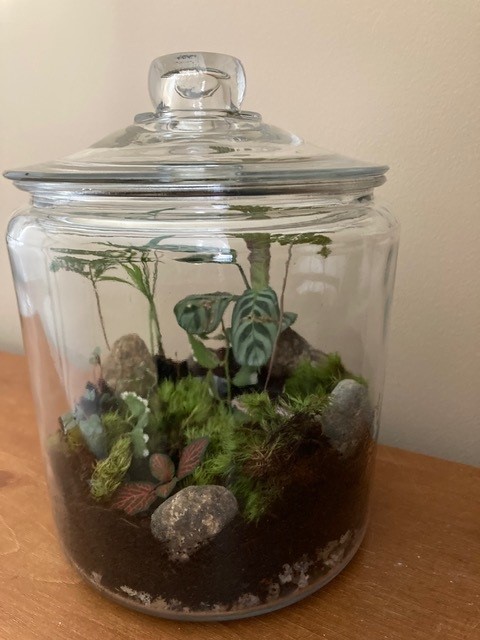If you need a gardening fix and can’t wait until the outdoor soil is dry enough to work, try creating a miniature indoor garden.
Rob Sinnott, owner with his wife, Anna, of Terrarium at 98 Cross St. North in Portland, will be glad to help. The couple opened the business last August – an amalgam of tropical plant shop and eatery serving light meals and snacks along with wine and beer.
What interested me most was the chance to create a terrarium, basically a small garden in a sealed container or a miniature greenhouse that replicates a tropical landscape. I’d never created one or even seen someone else build one – a major gap in my gardening career.
Sinnott was glad to help even though I walked in off the street without any warning. If you come in as a group of 10 or more (a nice idea for a team-building or social outing), you’ll need a reservation.
Step one is to select a container. Prices start at $25 – about the size of a quart canning jar – but I wanted the full experience, and so I picked one about 8 inches in diameter, costing $70. That price includes all the materials – including plants – to complete the project.
Next, put a layer of pebbles in the bottom of the container, about as deep as a single finger. Cover the pebbles with soil. The soil you’ll use is made up of coir, or coconut fiber, an environmentally preferable alternative to peat; lava rock (which I learned in Hawaii has minerals that plants love); earthworm castings and horticultural charcoal.
Sinnott suggested that I make the soil deeper on one side of the container in order to create an artificial hill. The slope would show off the different plants better. I followed his suggestion, but I think I inadvertently shrunk the hill while planting. The rear in my terrarium is a bit higher, but not as much as I thought/hoped it would be.
For planting, I started with moss, which has no roots and is short, so is ideal for the foreground and to fill space between the other plants. Next, I added a ‘Burle Marx’ calathea, one of more than 50 plants (!) named after the late Roberto Burle Marx, a world-famous Brazilian landscape architect (1909-1994) and one of the first to speak out against the deforestation of rain forests.
From there, I added a rabbit’s foot fern, named for the furry rhizomes that grow along its roots on the surface of the soil. I followed up with a parlor palm. In a pot, the palm can reach 4 feet tall, but it’s a slow grower so unlikely to outgrow my terrarium. My favorite plant in the design, so I put it right up front, is a fittonia. It has distinctive small striped leaves, and I picked the brightest hue – red with green – so that it would stand out.
I wondered if terrariums ever have flowering plants. It turns out some of the foliage plants that I used, including the calathea and fittonia, could produce small flowers eventually. Sinnott also sells small orchids that can go in your terrarium, but they cost extra. By the time I asked about flowers, my terrarium was already just about full, so I wasn’t tempted.

Columnist Tom Atwell strolled into Terrarium, a new business in Portland’s Old Port and built himself this terrarium. Photo by Tom Atwell
One final addition came as a surprise. It’s fauna, not flora, from the animal kingdom, so we again have pets in the house – although they likely won’t escape the terrarium. They are springtails; the Latin name is Collembola. Springtails used to be classified as insects, but scientists have now separated them because their mouthparts are internal, not external. Their job is to eat mold, according to Sinnott, which could otherwise get out of control in the moist conditions of the terrarium.
Once you get it home, place your terrarium in bright but indirect light – I’m going with my office desk – and give it only about two milliliters of water every three months.
As a busy outdoor gardener, I’d have thought terrariums might be a winter project and wondered how the business would fare in the summer. Sinnott hasn’t yet been open in the summer, but he hopes people will be coming in and says it’s a great rainy day activity. Though I built my terrarium alone, it makes a good social activity, too. “I was surprised at the number of couples on their first dates we’ve had,” Sinnott said.
Sinnott studied horticulture at Southern Maine Community College and worked at local nurseries before opening Terrarium. His wife learned cooking firsthand; her parents were in the restaurant business, and her first job was as a prep cook for her father.
The couple wanted to own a business where both of their talents could be put to use. It looks like they found it.
Tom Atwell is a freelance writer gardening in Cape Elizabeth. He can be contacted at: tomatwell@me.com
Send questions/comments to the editors.



Success. Please wait for the page to reload. If the page does not reload within 5 seconds, please refresh the page.
Enter your email and password to access comments.
Hi, to comment on stories you must . This profile is in addition to your subscription and website login.
Already have a commenting profile? .
Invalid username/password.
Please check your email to confirm and complete your registration.
Only subscribers are eligible to post comments. Please subscribe or login first for digital access. Here’s why.
Use the form below to reset your password. When you've submitted your account email, we will send an email with a reset code.